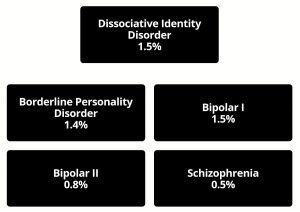DID is commonly thought of as a rare, exotic disorder, only slightly more common than unicorns. This is far from the truth.
It’s not easy to notice
DID isn’t rare, but it is very good at flying under the radar and not being noticed. One proof of this is that it takes, on average, seven years of being in the mental health system, before being diagnosed with DID. And by the time DID is correctly identified and diagnosed, most people have a list of other, mistaken diagnoses a mile long. Two common misdiagnoses are borderline personality disorder and schizophrenia.
DID compared to some other conditions
You might not believe me when I say it’s not rare, so let me give you some context using numbers straight out of the Diagnostic and Statistical Manual, more commonly known as the DSM. This is the official book for diagnosis mental health issues. These are the percentages of the population for each issue:

This means Dissociative Identity Disorder is as common as Borderline Personality Disorder, as common as Bipolar I, and more common than Bipolar II! And notice it’s 3 times more common than Schizophrenia!
To make it even more clear how common it is, I live in a town of about 2,100 people. It’s a small town! But based off the prevalence rate of 1.5%, we can expect that 31 people in my small town have DID. Would you call that rare?

So what do you think about this? Are you surprised?
